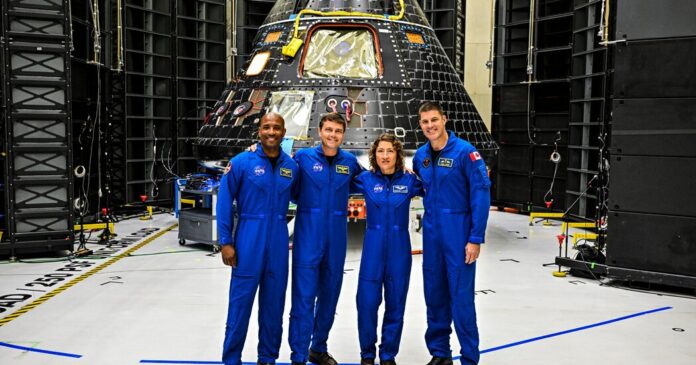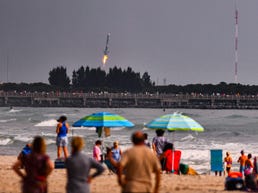For NASA and its astronauts, the moon is not farther away, but it is sliding further into the future.
Space agency officials announced on Tuesday that the Artemis 2 mission, the first American mission to send astronauts near the moon in more than 50 years, will not take place late this year as planned.
They set a target date of September 2025 for the mission, which will orbit the moon without landing on it.
The delay to the Artemis 2 mission also delays the subsequent mission, Artemis 3, which involves landing two astronauts on the moon near its south pole. This will not happen now before September 2026.
Artemis II will be the first mission to send astronauts into space using NASA’s massive Space Launch System rocket and Orion capsule, and NASA officials want to fix potential problems that could put the crew in danger.
“We’re not flying until it’s ready,” NASA Administrator Bill Nelson said during a news conference Tuesday afternoon. “Safety is paramount.”
As for the mission delay, officials cited a slew of technical issues including concerns about the electronics in the life support system that will keep the astronauts alive inside Orion, continued analysis of corrosion of the capsule’s heat shield during a previous uncrewed mission and repairs to the launch tower.
Unlike the Apollo missions, Artemis 2 will not enter lunar orbit; The Orion capsule will swing around the moon, using lunar gravity to return it to Earth for a landing in the Pacific Ocean. The entire trip should take about 10 days.
The crew will consist of three NASA astronauts – Reed Wiseman, Victor Glover and Christina Koch – and Canadian astronaut Jeremy Hansen.
Amit Kshatriya, deputy associate administrator in charge of NASA’s Moon to Mars program, said the discovery of valve problems in the Orion capsule’s life support system was the main reason for the Artemis 2 delay.
Fuses intended for the Orion capsule for Artemis III failed tests. “It gave us pause and look at that arena in a more detailed way,” Mr. Kshatriya said.
The Artemis II valve components had passed the tests and were installed, but “it became clear to us that it was unacceptable to accept those devices, and we needed to replace them in order to ensure the safety of the crew.” Kshatriya said.
NASA has also discovered a potential shortage of Orion batteries if the spacecraft needs to quickly separate from the rocket in an emergency, he said.
Even with the change in destination, key parts of NASA’s human spaceflight plans — the SLS rocket and the Orion capsule — had already been in development for years and remained unchanged.
Initially, the pace of the Moon’s return was slow, with astronauts not scheduled to land until at least 2028. Then in 2019, Vice President Mike Pence, who chaired the National Space Council, announced a sudden acceleration and said American astronauts would walk. On the moon again by the end of 2024 “by any means necessary.”
Pence and other critics said NASA was not acting with urgency, noting that only eight years had passed between President John Kennedy’s famous 1961 announcement of the plan to reach the moon and the Apollo 11 landing.
Mr. Pence also raised the specter of China, which had just placed a robotic lander on the far side of the moon and aims to land astronauts on the moon’s surface by 2030.
The moon program was called: Artemis, who in Greek mythology is the twin sister of Apollo.
In 2021, NASA hired Elon Musk’s SpaceX to build the Artemis III lander. The company is modifying the giant Starship rocket to be able to transport two NASA astronauts from lunar orbit to the surface of the moon.
NASA’s accelerated schedule is beginning to slip. Artemis I, a test launch of the SLS rocket that sent an unmanned Orion capsule on a weeks-long test flight around the moon, was scheduled for late 2020 but did not launch until November 2022.
Artemis I was largely successful, and NASA officials hoped Artemis II would follow two years later.
Although NASA’s budget has received significant increases in recent years, it still represents a much smaller slice of the federal budget than it did at the height of the Apollo program in the 1960s.
In December, the Government Accountability Office said the December 2025 goal for an Artemis 3 lunar landing was unlikely, citing overly optimistic timelines for the development of the Starship lunar lander and the spacesuits that astronauts would need to walk on. the moon.
Two Starship launches last year failed to reach orbit, although SpaceX said both tests provided plenty of data to make improvements. If the spacecraft takes longer than the average large project at NASA, it will not be ready until 2027, the accountability office said.
The delay allows SpaceX more time to address spacecraft development challenges, including a full unmanned lunar landing for the vehicle, now scheduled for 2025.
NASA associate administrator James Frey said the revised Artemis schedule was not overly optimistic, though he acknowledged the possibility of additional delays.
“We tried to address the unknowns and put a realistic plan in place,” Mr. Free said.
Other parts of NASA’s lunar program also did not go as planned.
On Monday, Peregrine, a robotic commercial lunar lander carrying five experiments for NASA, was successfully sent on a trajectory towards the Moon after launch, but then its propulsion system suffered a crippling failure shortly thereafter. While this represents a setback for NASA’s lunar studies, it is unlikely to increase Artemis delays.
in Latest update On Tuesday afternoon, Astrobotic Technology of Pittsburgh, which built the spacecraft, said it could run out of propellant for its maneuvering thrusters in about 40 hours.
“Given the fuel leak, unfortunately, there is no chance of a smooth landing on the moon’s surface,” the company said. Engineers continue to look for ways to extend the life of the spacecraft and collect data that can help with future missions.
NASA already has additional experiments booked on other commercial landers, as part of efforts to conduct scientific research on the Moon at a lower cost. NASA officials said they expect some of these commercial missions to fail.
However, NASA may also be cautious about moving forward with Astrobotic’s second mission, which is taking a $433.5 million rover called VIPER to the Antarctic region where it will explore water ice and other resources. That flight will use a larger lander called Griffin.
The rover is the most complex and expensive payload NASA has planned for commercial lunar missions.
#NASA #postpones #Artemis #astronaut #mission #moon

































